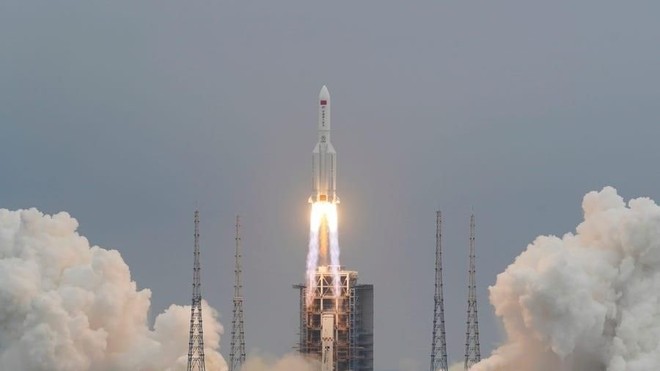Why the Chinese rockets fell out of control to Earth: American experts point out important flaws in the design
- Tram Ho
On April 29, at the Van Xuong Spacecraft Launch Center in Hainan Province, China successfully launched the first module of the Tianhe space station with the Truong Chinh 5B rocket, marking an important step in the build the country’s own space station. However, instead of falling to a predetermined place in the sea like the previous rockets, the central stage of the Truong Chinh 5B boosters started spinning around the Earth in a low orbit in a state of out-of-control.
With a weight of about 21 tons, 30m long and 5m wide, the remnants of the Truong Chinh 5B rocket are flying in orbit around the Earth every 90 minutes / rev, with a speed of 27,600 km / h at an altitude of over 300 kilometer. Since the end of last week until now, this remaining part has decreased altitude by nearly 80km. According to the observations of the underground amateur astronomers, this missile is in a state of extreme instability.

Truong Chinh boosters 5B
Some calculations show that the central floor of the Truong Chinh 5B missile will plunge into the atmosphere on May 8. When it crosses the Earth’s atmosphere, it could be burned, but it is likely that large pieces of the missile will remain and will fall scattered over an area of 160km wide.
Worth mentioning, this is not the first time that China’s Truong Chinh 5B missile has fallen into a state of out-of-control during the biosphere. In May 2020, a similar incident happened.
“This is the second launch of this missile, Truong Chinh 5B”. “The first launch took place a year ago. When the rocket returned, it did some damage to villages on Ivory Coast (Africa), causing some metal debris to drop all over the place.” place on an area 100 miles wide. Thankfully no one was injured, “said Jonathan McDowell, an Astrophysicist at the Center for Astrophysics at Harvard University.
Notably, the loss of control by China with the central layer of the Truong Chinh 5B missile was not a mistake or an accident. Instead, the main reason comes from the design of this rocket. According to Inverse, conventional missile manufacturers (such as those of Russia and the US) have to take into account the freefall of missile fragments and ensure that doesn’t happen. To do this, the missile needs to be fitted with an additional booster stage that directs it to safely land-like landing spots after being rolled back. Or, the missile must be equipped with a stabilization system and a restartable engine, which can help the missile slow down and rotate 180 degrees to fall into the ocean.
However, the Truong Chinh 5B missile line is not fully integrated with the two above features.
“And so it just goes into orbit the old, uncontrollable way that the biosphere is, and that’s very unusual today,” said analyst McDowell. Although there is still no international law that requires rockets to be built as above, but space agencies around the world comply with this regulation.
“When they do that design, they should stop and think,” You know, that leaves a lot of debris in orbit, we should change the design of the engine. ” did not. This is a real mistake, “concluded expert McDowell.
Check out Inverse
Source : Genk
